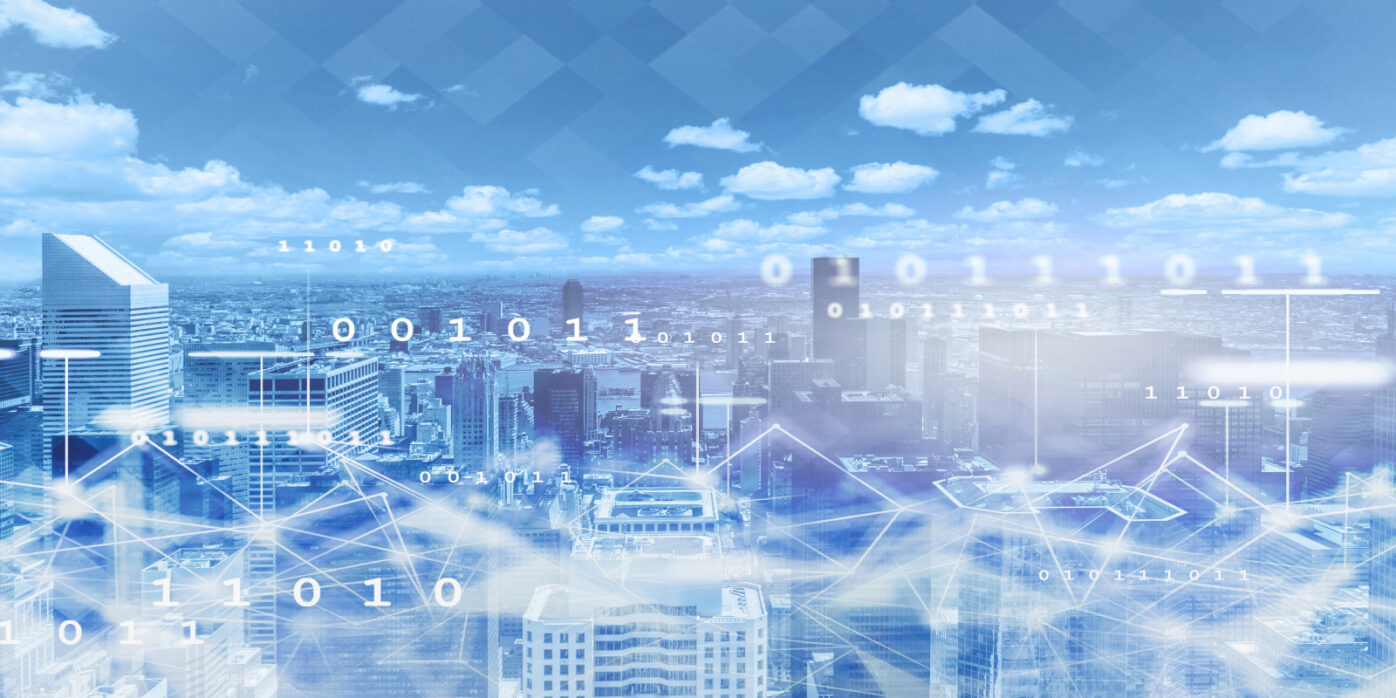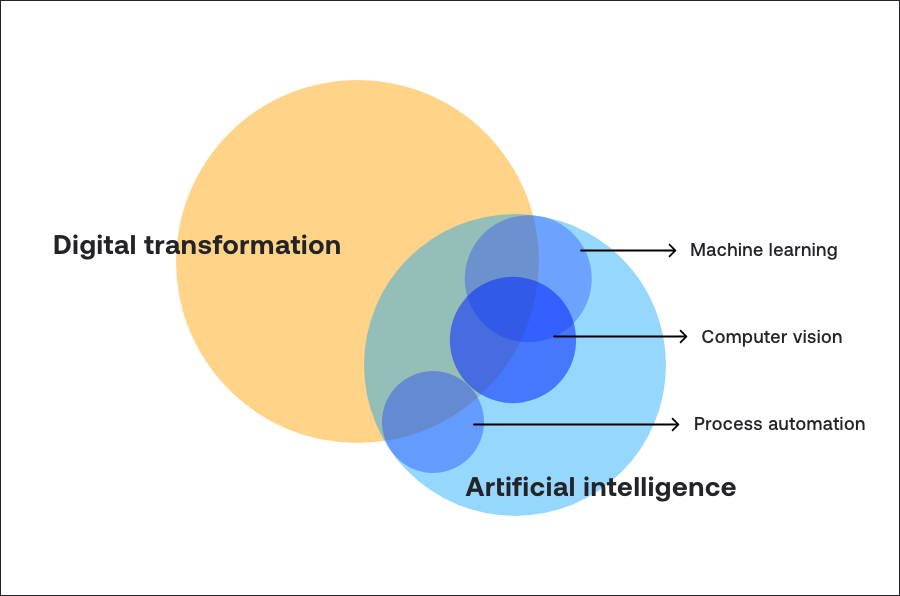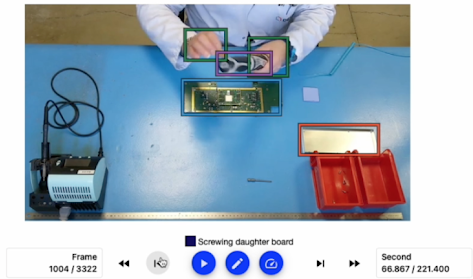The role of artificial Intelligence in digital transformation

Digital transformation is the integration of digital technology into all areas of a business, fundamentally changing how you operate and deliver value to customers. It’s also a cultural change that requires organizations to continually challenge the status quo, experiment, and get comfortable with failure.
When done right, digital transformation delivers operational improvements to your organization at every step along the way. Artificial intelligence is a set of technologies that can accelerate your digital transformation and help deliver the value your business expects.
For decision-makers who may be new to either digital transformation or AI, this article explores how artificial intelligence enables digital transformation through 3 related technologies:
- Machine learning (ML)
- Computer vision (CV)
- Process Automation (PA)
What is the current status of digital transformation?
Digital transformation has been a topic of interest in executive suites since about 2015. (See Figure 1.)
Despite the steady growth of interest through 2020, many companies reported low success for their efforts. Some consulting firms estimate failure rates as high as 70% for digital transformation projects. Failures occurred mainly because of internal resistance to change.

Figure 1. The relative number of search queries on digital transformation worldwide, 2004-2021. (Source: Google Trends)
COVID-19 made digital transformation an even more urgent priority. It changed the way organizations work and how people interact, disrupted purchase behavior and demand, and upended labor markets.
A McKinsey survey found that just 11% of 1,140 business executives believe their current business models will be economically viable through 2023. A 2021 survey from PwC found that 60% of executives believe digital transformation will be critical to their company’s growth in 2022.
Current adoption of artificial intelligence (AI)
Corporate interest in AI
AI commands almost as high a level of corporate attention as digital transformation. Figure 2 shows how worldwide interest in artificial intelligence has fared since 2004, as measured by Google search volume. Note that interest in AI has roughly paralleled the rise of interest in digital transformation since 2014.

Figure 2. The relative number of search queries on artificial intelligence worldwide, 2004-2021. (Source: Google Trends)
In a 2021 study, 56% of about 1,800 respondents told McKinsey their company now applies artificial intelligence in one or more areas of operations. Figure 3 shows how digital transformation and artificial intelligence overlap as elements of IT strategy.

Figure 3. The conceptual relationship between digital transformation and artificial intelligence.
Machine learning (ML)
Machine learning is a subset of AI which allows a machine to learn automatically from past data without explicit programming. Instead, machine learning uses algorithms that enable computers to learn from the data they process.
For example, instead of programming computers to perform prescribed actions in well-defined situations, ML uses models to define possible variations in the data. Then, it trains computers to adapt to the variations. The use of models also enables computers to identify patterns in data and make predictions based on the patterns it identifies.
ML can use any of 3 methods to train computers:
- Supervised machine learning
- Unsupervised machine learning
- Reinforcement learning
Here’s a brief discussion of each method and how we apply them for our customers in different computer vision use cases:
1. Supervised machine learning
With supervised ML, you first feed input data into a computer. The computer then digests the input data, interprets it, and generates output data.

Figure 4. Process diagram for supervised learning.
What does it mean for the computer to interpret input data?
Your input data would contain a range of variations you want the computer to interpret. For example, let’s say you want to train a computer to recognize individual trees within clusters of trees. (Figure 4.)
Your input data would include many aerial images of clusters of trees. Your input data may also include details of objects you want the computer to recognize as not belonging to the group.
Through carefully crafted algorithms, models, and input datasets, ML enables the computer to:
- Recognize similarities among the variations.
- Classify the variations by their similarities and differences.
- Act appropriately on the classifications.
The algorithms create models, and the models teach the computer to classify the data they process.
2. Unsupervised machine learning
Unsupervised ML doesn’t use labeled data inputs. The process relies instead on algorithms designed to identify relevant patterns.
Let’s say you feed a computer raw data about the demographics of visitors to a website. You also provide data about the behavior of these visitors on the site. The computer finds correlations in the input data. Then it uses the correlations to cluster the visitors and their behavior by identifiable characteristics. The clusters are its output data.

Figure 5. Process diagram for unsupervised learning.
3. Reinforcement learning (RL)
Reinforcement learning is a training method for machine learning that uses trial and error. As a result, it’s well suited to situations where software developers can’t model all possible situations. It enables a system to learn interactively with its environment by using feedback from its own actions and experiences.
RL is useful when other forms of ML don’t work because developers can’t train a computer to respond to prepared data inputs. Even when programmers can’t anticipate all the situations a robot or a computer will face, reinforcement learning enables such a system to learn a skill, adapt it to a new task, or achieve optimization.
One example is teaching an autonomous vehicle to drive. Programmers can’t prepare the computer by preparing it in advance with all the situations it’s likely to experience on the road. Note that RL is not yet in production for autonomous vehicles.
Other uses of reinforcement learning
Besides autonomous vehicles, reinforcement learning is also used for these applications:
- Resource management, operations research, and simulation-based optimization.
- Robotics and industrial automation.
- Gaming and game theory.
- Personalized recommendations.
- Autonomous vehicles.
Reinforcement learning is also useful in information theory, control theory, multi-agent systems, swarm intelligence, statistics, and genetics.
How it works
Developers create a method that rewards desired behaviors and punishes undesired ones. They do so by assigning positive values to encourage the system to take desired actions. Conversely, negative values discourage undesired behaviors.
The system achieves an optimal solution in the long term by seeking the greatest possible reward.
Limitations of reinforcement learning
Although reinforcement learning is a topic of intense interest among AI pioneers, it’s not widely used because it requires more data and computing power than the other forms of machine learning.
To use RL effectively, data scientists must prepare an appropriate simulation environment. The environment they prepare depends on the task to be performed. For example, it’s relatively easy to build simulation environments for games with static rules. But it’s much harder to build simulation environments that model complex environments such as a busy traffic intersection. Supervised learning has an advantage over reinforcement learning in some situations because it can often deliver faster, more efficient results.
Examples of machine learning techniques in computer vision
Computer vision is a field of artificial intelligence (AI) that enables systems to derive meaningful information from digital images, videos, and other visual inputs. The systems then take actions or make recommendations based on that information.
Computer vision is the basis of visual intelligence. It leverages the processes and methods described above. Here are two examples of machine learning and computer vision from the electrical power transmission industry.
Identifying defective insulators
Here is a real example of supervised machine learning in use. A transmission company has leveraged Alteia platform capabilities and pre-built ML models to enable a fast, accurate, and labor-efficient way to identify its network components (Figure 6.)

Figure 6. Example of supervised machine learning and computer vision. The image helps train a system to recognize defects in an electrical insulator.
In this example, the training datasets would include hundreds of labeled images of power lines and insulators in different configurations, with or without defects. Once in production, the algorithm may get some of its classifications wrong. For that reason, the Alteia platform provides re-annotation tools for incremental learning.
The platform enables validation steps during the inspection process. A human reviewer tells the computer when it has made an error and then validates the dataset to create an inspection report. Over time, the computer learns to improve its classification and overall performance. Most models are inaccurate at the beginning of the supervised learning process, but they improve as the computer processes more input data and receives more supervision.
Classifying objects in a lidar point cloud
You can use supervised machine learning to automatically classify many kinds of features in a point cloud formatted as a LAS file. (That’s a file format used to exchange and archive lidar point cloud data.)
The model doesn’t use predefined rules to identify specific features such as buildings or ground. Instead, you provide examples of features of interest. Then, you use those examples to train a neural network to recognize and classify the features in other data. The below figure shows a point cloud where a computer has identified relevant objects, including transmission lines, towers, vegetation, and buildings.

Figure 7. Computer vision identifies elements of an electrical grid in a point cloud. Towers and power lines are in yellow, vegetation is green, the ground is brown, and buildings are orange.
Assembly-line analysis for quality control in manufacturing
Here’s a real example that mixes supervised and unsupervised learning on a manufacturing assembly line.
The company collects video streams and images from cameras mounted above each workstation. (Figure 8.) Tests at the end of the assembly line check the quality of subcomponents or finished goods. The company compares test results at the end of the line with the video streams from the manufacturing process. Then AI algorithms look for correlations between the 2 data sources.
With unsupervised ML, they may learn that certain practices on the assembly line are correlated with higher levels of defects at the end of the line. Such insights may help the manufacturer predict future failures without human involvement.

Figure 8. Machine learning and computer vision enable manufacturers to improve processes on assembly lines. A company collects video streams from cameras mounted above workstations. Tests at the end of the assembly line check the quality of subcomponents or finished goods. A comparison of test results looks for correlations between defects and assembly line activities.
Process Automation
Process automation performs a wide range of defined actions faster and more consistently than humans. It may execute repetitive tasks such as these and more:
-
- Order and claims processing
- Invoicing and payments
- Human resource records
- Customer onboarding
- Tax return preparation and filing

Figure 9. Process automation executes repetitive tasks to increase efficiency and reduce human error. It is well suited to performing the kinds of tasks shown here.
Process automation is generally used in high-volume, cumbersome, and repetitive tasks that involve structured data. For example, bots can copy and paste, make calculations, or connect to application programming interfaces (APIs). Using machine learning, PA can also reduce and fix human mistakes.
Benefits of process automation
By automating labor-intensive tasks, PA tools help businesses:
- Improve accuracy
- Increase speed
- Reduce costs
In industries such as insurance, finance, law, and manufacturing, PA helps organizations reshape the way they operate. By automating back-office tasks, companies can be more responsive at many touchpoints with their customers and suppliers. As a result, they can focus on higher-value activities such as customer care, sales, and marketing.
Process automation enables companies to improve their customer experience, which improves customer retention.
How Alteia enables process automation in the power and utilities industry
Electric utilities and power transmission companies face a big challenge in managing the growth of vegetation. When foliage grows too near to power lines and equipment, it can cause wildfires and service interruptions.
For many companies in this sector, the annual cost to control vegetation is counted in millions or tens of millions of dollars. That’s why such companies are exploring new technologies and methods to reduce interruptions of service and the costs of trimming trees. Transmission companies often work with local contractors to trim foliage. Processes for managing such relationships could be much more efficient.
Power companies can automatically calculate the risks of encroachment between conductors and vegetation. They can do so by using a combination of Lidar scanning technology, machine learning, and process automation.
Alteia’s visual AI platform can create and automatically send work orders to contractors based on their location and the urgency of risk mitigation. The automation can set priorities, validate trimming contracts, and run billing processes.
How Alteia enables process automation for digital phenotyping
Limagrain Groupe offers another example of process automation in agriculture. The agricultural cooperative and international seed group use a sensor-based workflow for phenotyping. Their process gathers data from a variety of sensors and carriers. The sensors include RGB and multispectral technologies, and the carriers include drones, robots, and more. Limagrain’s workflow then characterizes plant traits across the company’s R&D plots worldwide.
Alteia’s visual AI platform enables Limagrain to scale the workflow of gathering and standardizing data. Process automation helps manage quality control and develops real-time, data-driven crop insights. These examples show how diverse organizations are leveraging artificial intelligence to achieve digital transformation. And they’re generating big benefits along the way.
Today, complex organizations are thinking about how to best leverage data to modernize and digitize their business.
We at Alteia are here to help.
We work with our clients to quantify their progress, to help ensure they stay true to the original goals for their AI projects. We’re alongside them as they enter new markets and segments. We enable visual AI to help our clients adapt to a changing global economy and navigate newly competitive landscapes. Let Alteia help ensure that your company keeps winning at AI and that you do so at whatever pace or scale suits you.
Sources
“PwC Pulse Survey: Executive Views on Business in 2022.” Undated. [Online article.]
“Global Survey: The State of AI in 2021.” McKinsey & Company. December 8, 2021. [Online article.]
“Flipping the Odds of Digital Transformation Success.” BCG. October 29, 2020. [Online article.]
Dig deeper
“AI Is Vital to the Success of Digital Transformation Strategy.” The Keen Folks. Undated. [Online article]
“Digital Transformation & Artificial Intelligence: Is Your Organization Ready?” Bhaskar S. Undated. Digité.com. [Online article]
“A Digital Transformation Driven by Artificial Intelligence.” Kim del Fierro. March 28, 2021. Globaltrademag.com. [Online article]